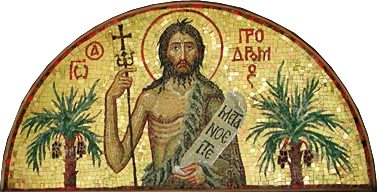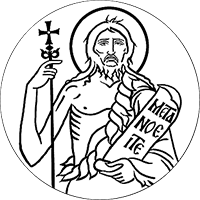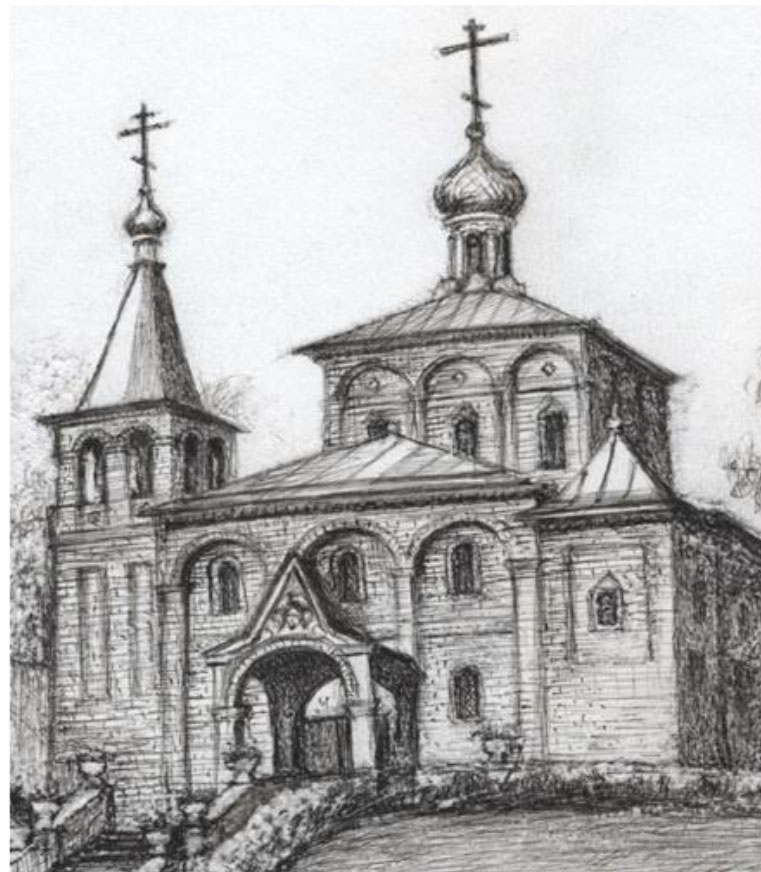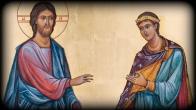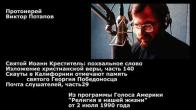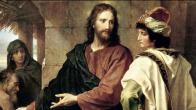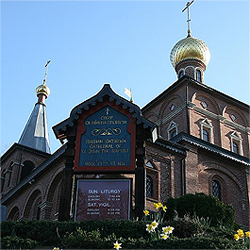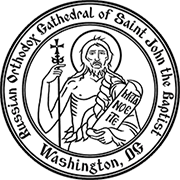You are here
Commemoration of the Dead
Often, parishioners pose questions regarding the eternal fate of the deceased, how and when they should commemorate the souls of the deceased, what affect our commemorations have upon them, and the symbolism behind specific days of commemoration. Below, we present an article on these matters. The information is drawn from a number of sources, including Divine Scripture, Tradition, the works of the Holy Fathers of the Church, the lives of saints, etc.
Orthodox Christians live in anticipation of the hour of their death, their birth into a new life and their meeting of the Lord, to Whom they pray: “Grant unto me to remember death.” The time “about which day and night I fell down and fervently prayed” approaches. The soul quakes and suffers as it leaves the body and moves through the realm of the “princes of the air.” The prayers of one’s loved ones and of the Church ease the soul’s journey. With lighted candles, and with a lampada burning before the icons, pious Christians read the “Canon for the departure of the soul from the body” over the dying person. Over the body of the deceased, they read prayers from the “Rite following the departure of the soul from the body.”
Private prayer at home, commemoration at the Liturgy, and alms on behalf of the deceased all lessen the suffering of the sinful soul, and can even free it from the bonds of hell. In the writings of St. John the Merciful, we read the story of a certain imprisoned youth whose parents thought he was dead. On the days on which his parents offered fervent prayers for him, he was freed from his shackles. Such is the power of prayers of commemoration.
The third, ninth and fortieth days are days of special prayers for the dead.
The Third Day
Commemoration of the dead on the third day after death is an ancient, Apostolic tradition. It is appointed first of all because the reposed had been Baptized in the name of the Father, Son and Holy Spirit, the One God in Trinity. It is our hope that he maintained intact the Faith he accepted at Holy Baptism. Because throughout his life he prayed for remission of sins to God, One in Trinity, he is commemorated on the third day. Second, he strove to preserve three Gospel virtues – faith, hope, and love – which form the basis for our salvation. Third, his being consisted of three parts: spirit, soul and body, all three sin together; and after man’s translation to the world beyond the grave, all three need to be cleansed of sin.
In addition to such a theological significance, commemoration of the reposed on the third day has a mystical significance touching on the state of the soul beyond the grave. When St. Makary of Alexandria asked the Angel accompanying him in the desert to explain the meaning of church commemoration on the third day, the Angel answered: “When on the third day there is an offering in the church, the guardian angel lessens the sorrow the soul of the deceased experiences upon separation from the body. This is the result of the petitions and praise offered in the Church of God on its behalf. As the soul, accompanied by Angels, is permitted to travel for two days about the earth where it will, this engenders in it blessed hope. Sometimes, the soul, which loves its body, hides near the house in which the body rests, and thus spends two days, like a bird searching for its nest. A virtuous soul goes to those places in which it used to perform its righteous acts. On the third day, the One Who rose from the dead on the third day directs that, in imitation of His Resurrection, the Christian soul ascend in order to bow down before God.
The Ninth Day
On the ninth day, also in accordance with Apostolic Tradition, the Holy Church offers prayers and the Bloodless Sacrifice for the reposed. It prays to the Lord that the soul of the reposed be made worthy to be joined to the host of the saints by the prayers and intercession of the nine ranks of Angels.
Reporting what had been revealed to him by the Angels, St. Makary of Alexandria, states that after bowing down before God on the third day, the soul is directed to view the various pleasant abodes of the saints and the beauty of Paradise. The soul in wonder examines all of this for six days, and praises God, the Creator of all. Contemplating all of this, the soul changes, forgetting the sorrow it felt while in the body. However, if it is guilty of sins, then witnessing the saints’ enjoyment causes it to grieve and accuse itself “O woe is me! How much I fussed vainly in that world!. Distracted by my enjoyment of lust, I spent most of my life carelessly, not serving God as I ought, so that I might be worthy of such grace and glory. Woe is poor me!” After six days of viewing the joys of the righteous, it again is taken up by the Angels to bow down before God.
The Fortieth Day
In ancient times, the deceased were mourned for forty days. The number forty is a remarkable one, often encountered in Divine Scripture. The Hebrew people fed upon manna in the desert for forty years. The prophet Moses fasted for forty days and nights in his travels to Mt. Horeb. After Baptism, the Lord Jesus Christ spent forty days and nights in the desert, and after His Resurrection likewise spent forty days teaching the Apostles the mysteries of the Kingdom of Heaven.
Following the Apostolic tradition that adopted the ancient Jewish custom of the Old Testament Church to mourn the deceased for forty days, the Holy Church has since its early days properly and piously established the rule of commemorating the reposed over the course of forty days (the “soroko-ust”) and especially on the fortieth day (“sorochiny”). As the Lord Jesus Christ, spending forty days in fasting and prayer, conquered the devil, so the Holy Church, offering prayers, alms and the Bloodless Sacrifice over the course of forty days, asks God’s grace for the reposed, that our enemy, the prince of darkness of the air, the devil, might be defeated, and that the deceased might inherit the Heavenly Kingdom,
Considering the state of the soul after the death of the body, St. Makary of Alexandria adds: “After the second prostration, the Lord of all commands that the soul be taken to hell to be shown its various parts and the various ignominious tortures that cause the souls of sinners incessant wailing and gnashing of teeth. The soul travels throughout these various places of torment for thirty days, in fear and trepidation that it might be imprisoned in one of them. On the fortieth day, it again is taken up to prostrate itself before the Lord God, and then, based on its actions, Judge determines where the soul should be closeted.”
St. Symeon of Thessalonika writes: “The forty days of prayer are done in memory of the Ascension of the Lord, forty days after His Resurrection, [in hopes] that likewise, the deceased, rising from the tomb and ascending to meet the Lord, might taken be taken up in the clouds, and thus ever be with the Lord.” (Novaya Skryzhal’ , Part 4, Chapter 472).
The Anniversaries
A Christian’s date of death is his birthday into a new, better life. This is why we celebrate the memory of our brothers and sisters one year after the day of their death. Celebrating their second birth, into Heaven, we beg God’s mercy, that the Lord have mercy upon their souls, that He grant that the homeland prepared for eternal enjoyment, and that he make them once again residents of Paradise.
As love, according to the Apostle, never ceases (1 Corinthians 13:8), so death does not sever the union of love between us and our departed brothers and sisters. They live in spirit with us, who remain on earth; we keep our memory of them alive in our hearts. We especially rekindle that memory on the days of their death, anniversaries on which we hurry to prayer, faith and love, to the most efficacious means by which to satisfy the demands of a heart burning with love, and to bring joy and ease to the souls of those who have moved away from us and into the world upon high.
The godiny, commemorations on the first anniversary of a person’s death, and godovschiny, commemorations on subsequent anniversaries, should be done without fail, guided by that living faith that in light of the obedience of the Lord Himself to the human conditions of time following his Incarnation, our repetition of anniversary commemorations, or rather our repetition of the day on which the deceased departed to a new life, have an active purpose, affecting his soul and his fate.
In the Orthodox Church, there are festive days on which all the reposed are commemorated: Ancestral Saturdays - Meat-fare Saturday – 8 days before the first day of Great Lent; the 2nd, 3rd, and 4th Saturdays of Great Lent; Trinity Saturday – the Saturday before the Feast of Pentecost; and St Dimitry Saturday –the Saturday preceding 26 (Old Style) October, the feast day of St. Dimitry Donskoy, and Radonitsa, the Tuesday following St. Thomas Sunday.
On all forty days from the date of death, and on all special days of commemoration appointed by the Church, one should offer lists of names to be commemorated at the Liturgy and at the Panikhida. People order the performance of the soroko-ust as soon as a death has occurred. There is a pious custom calling for the Psalter to be read for the deceased over the course of the first forty days. At each “Glory,” the deceased is commemorated and the prayer “Remember, O Lord our God…” from the “Rite following the departure of the soul from the body” is read. At home, we read the 17th kathisma of the Psalter.
Archpriest Victor Potapov
PARISH LIFE
RECENT VIDEOS
Address of our Cathedral
Subscribe to our mailing list
While all the materials on this site are copyrighted, you may use them freely as long as you treat them
with respect and provide attribution on the Russian Orthodox Cathedral of St.John the Baptist of Washington DC.
